- News
- Reviews
- Bikes
- Components
- Bar tape & grips
- Bottom brackets
- Brake & gear cables
- Brake & STI levers
- Brake pads & spares
- Brakes
- Cassettes & freewheels
- Chains
- Chainsets & chainrings
- Derailleurs - front
- Derailleurs - rear
- Forks
- Gear levers & shifters
- Groupsets
- Handlebars & extensions
- Headsets
- Hubs
- Inner tubes
- Pedals
- Quick releases & skewers
- Saddles
- Seatposts
- Stems
- Wheels
- Tyres
- Tubeless valves
- Accessories
- Accessories - misc
- Computer mounts
- Bags
- Bar ends
- Bike bags & cases
- Bottle cages
- Bottles
- Cameras
- Car racks
- Child seats
- Computers
- Glasses
- GPS units
- Helmets
- Lights - front
- Lights - rear
- Lights - sets
- Locks
- Mirrors
- Mudguards
- Racks
- Pumps & CO2 inflators
- Puncture kits
- Reflectives
- Smart watches
- Stands and racks
- Trailers
- Clothing
- Health, fitness and nutrition
- Tools and workshop
- Miscellaneous
- Buyers Guides
- Features
- Forum
- Recommends
- Podcast
TECH NEWS
SRAM launches Red eTap wireless groupset
SRAM has announced the new wireless version of its top-level Red groupset, called eTap. The components, which have been trialled by the pro team AG2R La Mondiale throughout the 2015 race season, will be available in the spring.
Let’s crack into some bullet points on eTap to set the scene.
• The new range comprises two shifters, a front derailleur, a rear derailleur, plus the option of satellite shifters, called Blips.
• You upshift at the rear (move to a smaller sprocket on the cassette) by pushing a paddle behind the right brake lever.
• You downshift at the rear by pushing a paddle behind the left brake lever.
• You move the front mech by pushing both paddles at the same time.
• You shift using Blips on time trial and triathlon bikes, a BlipBox (more on that later) providing the power.
• Fitting the eTAP system to a new bike takes around 15 minutes.
• Pairing the various components so that they can communicate with one another takes seconds and needs to be performed only once.
• All components have LED battery level indicators.
Wireless operation
Shimano’s Di2 and Campagnolo’s EPS electronic shift systems have both been around for years now and are well established in the marketplace, so SRAM desperately needed to come up with completely new technology for its entry into this sector in order to compete. The brand looks to have delivered that with its wireless system.
When we say wireless, that means that there are no cables between the shifters and the mechs, and there’s no cable between the two mechs either. The components communicate with one another using SRAM’s own communication protocol, not ANT+ or Bluetooth, and the brand doesn’t believe that system is susceptible either to interference or to deliberate hacking.
Each component has its own battery. The derailleurs’ rechargeable batteries offer power for over 1,000km (625 miles) of typical riding while the CR2032 batteries in the shifters will need changing on average about once every two years, according to SRAM.
Let’s have a look at each of the components individually.
Red eTAP rear derailleur £420, 239g (including battery)
The rear mech is powered by a removable rechargeable battery that sits at the back of the unit. The battery snaps into place – it’s tool-free. Accelerometers wake up each component when the bike is moving and allow each component to enter sleep mode when the bike is not being used in order to preserve the batteries.

The maximum sprocket size the rear derailleur can handle is 28 tooth. SRAM anticipates that the eTap technology will eventually be extended to cover WiFLi applications (super-wide-ranging cassettes with larger sprockets), although no timescale has been set for that.
Like the SRAM Red mechanical rear derailleur, the eTap version has a carbon pulley cage and ceramic pulley bearings.
Red eTap front derailleur £265, 187g (including battery)
The front derailleur is powered by exactly the same type of battery as the rear mech; the two are interchangeable.
It features SRAM’s Yaw technology, meaning that it doesn’t require a trim position; there’s a single front mech position whatever rear sprocket you’re running the chain on.

When you move from the small chainring to the large chainring, the front derailleur slightly overshifts to get the chain up there, then moves the cage back inboard slightly to its standard big chainring position after a fraction of a second to avoid chainrub.
When you move from the large chainring to the small chainring, the front derailleur moves enough to get the chain down there. A fraction of a second later, once the chain is in its new position, the front derailleur cage moves further inboard to avoid chainrub.
Red eTap shifters £205 each, 260g (pair)
The shifters are each powered by a CR2032 coin cell battery that sits in a compartment underneath the hood. SRAM reckons these will last around two years (depending on how much shifting you do).
You perform shifts via a paddle that sits behind the brake lever. You push the paddle on the right shifter inward to move the chain to a smaller sprocket. You push the paddle on the left shifter inward to move the chain to a larger sprocket. You can hold each paddle in those shift positions to perform multiple shifts – if you want to go from the bottom of the cassette up to the top, say, you just push the left paddle and hold it there.
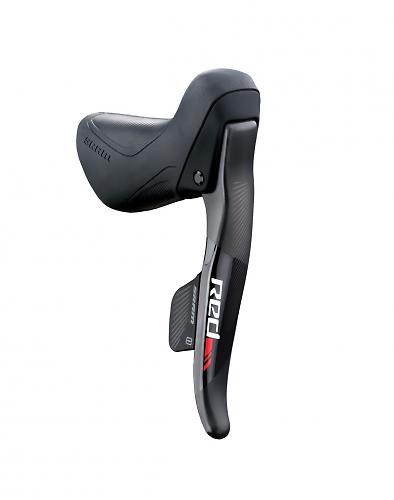
Whichever chainring the chain is in, you push both paddles at the same time to move it to the other one (so the eTap system could not work with a triple chainring setup).
The shape of the shifters has been modified from that of the SRAM Red mechanical shifters, but not radically. The levers are carbon and they’re adjustable for reach.
eTap functions very differently from SRAM’s existing DoubleTap mechanical system (where a short push moves the mech in one direction, a longer push moves it the other way).
Red eTap Blips £150 for four, 6g each
SRAM calls its optional satellite shifters Blips, and you can use up to four of them. They’re simply buttons that perform the same function as the shifter you plug them into. A Blip links to a shifter with a cable – the only cable in the eTap system.
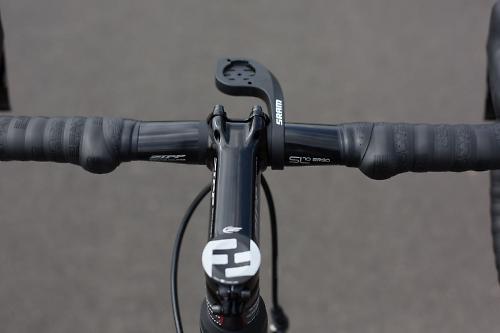
You can position Blips on the tops of your handlebar for use when you’re climbing, for example - they're bulging underneath the bar tape in the above picture - or on the drops for shifting when you sprint. They can go either underneath your handlebar tape or out in the open.
So, pressing a Blip connected to the right shifter moves the rear mech to the right; pressing a Blip connected to the left shifter moves the rear mech to the left; and pressing a Blip connected to the left shifter at the same time as pressing a Blip connected to the right shifter moves the chain from one chainring to the other.
Blips come with wire lengths of 150mm, 230mm, 450mm and 650mm. Even a 650mm blip weighs just 9g.
Red eTap BlipBox £215, 31g

The eTap shifters (above) are obviously designed for drop handlebars and aren’t suitable for a time trial or triathlon bike.
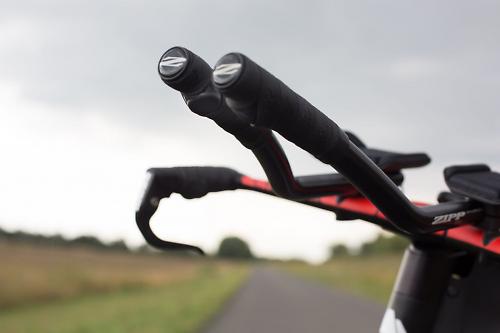
In this situation you can fit Blips to the ends of your aero extensions and close to your brakes at the ends of the base bar, and link them to a BlipBox which acts as the control module that sends the wireless signals for this kind or setup.
Other essentials and prices
You’ll also need a Charger Power Pack (£50) for recharging the derailleurs’ batteries, and a USB stick (£35, below) for firmware updates.
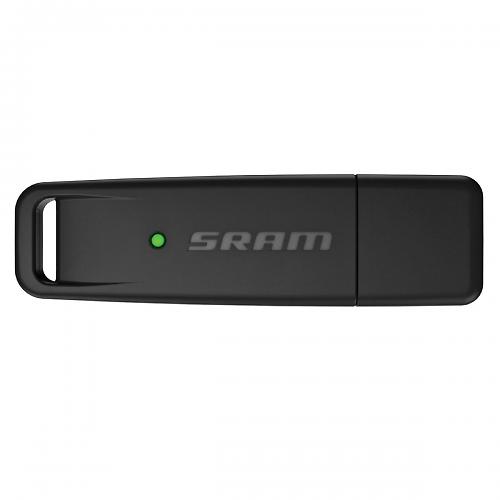
The total price of the standard eTap road system (shifters, derailleurs, Charge Power Pack, and USB stick) is £1,180 (more if you want Blips too).
Add in the cost of a cassette (£223), chainset (£361), bottom bracket (£29), chain (£38) and brakes (£228), and the price of a complete SRAM Red groupset with eTap shifting is £2,059.
For comparison, the list price for a Shimano Dura-Ace Di2 groupset is £2,999.99, while the list price for a Shimano Ultegra Di2 groupset is £1,999.99.
Is SRAM eTap a saboteur’s dream?
Is SRAM eTap susceptible to interference or even hacking?
SRAM says not, of course.
“Utilising 128-bit encryption, eTap shift signals are transmitted and received in accordance with SRAM’s proprietary wireless protocol known as Airea. Each time an eTap groupset is paired, a new encryption code is generated and assigned to the components in this group to ensure complete shifting security.”

The fact that Airea belongs to SRAM – it’s not an open system – means that the details of exactly how it works are not public. SRAM reckons this helps with security.
SRAM says it has simulated hundreds of eTap shifters shifting in the same place at exactly the same time and there has been no interference at all.
It also says that it has employed system developers, computer scientists and even hackers on the development of Airea and no one has managed to hack into it.
Compatibility
SRAM Red eTap shifters and derailleurs are compatible with all existing SRAM 22 chainsets, chainrings, chains, mechanical (non-hydraulic) brakes, and cassettes with a maximum sprocket size of 28 teeth.
Firmware updates
A USB stick is included with complete aftermarket groupsets. This allows your computer (Mac or PC) to communicate with eTap and update the firmware.
You can customise the function of Shimano’s Di2 system to some extent via a computer. You can change which lever operates which mech, for example. SRAM won’t be offering this option, at least not in the foreseeable future. The brand reckons this would add an unnecessary level of complexity to the system.
Charging
SRAM reckons that you’re looking at over 1,000km (625 miles) of use between charges for the derailleurs, and about two years of use per CR2032 battery in each shifter.
You can check the charge of different components at any time. LED lights indicate the current level of charge.
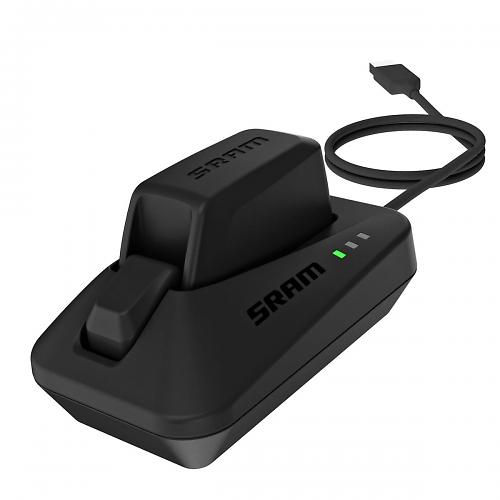
If you ignore these LEDs and allow the rear mech battery to run out, you can swap the front mech battery on to the rear, foregoing front shifting for the journey home.
If you run out of both, you can manually put the chain onto the gear you want and ride home singlespeed.
Recharging a derailleur battery is simply a case of unclipping it and putting it on the USB-powered charger for 45 minutes.
The shifter batteries aren’t rechargeable. When they run low you simply swap new CR2032 batteries into the ports in the hoods.
Reliability
After the high profile recall of its Road Hydraulic Disc brakes, SRAM appears to have taken no chances with the pre-announcement testing of its eTap system.
SRAM’s Scott McLaughlin says that over 750,000km (469,000 miles) of riding has been logged on eTap since the start of development in 2011, with non-logged distance likely to mean the true figure is over a million kilometres (625,000 miles), and there have been very few issues.
Many professional athletes have been using the eTap equipment in all conditions over the past couple of years, including the AG2R La Mondiale pro team.
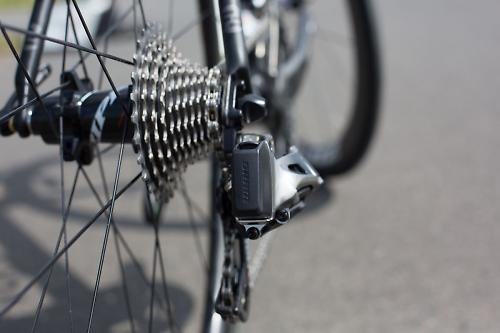
“eTap has been completely flawless from the start,” says McLaughlin. “We can count on the fingers of one hand the number of times someone has missed a shift.”
SRAM says that it has tested the eTap components after an hour submerged under a metre of water, power washed them, and checked for dust ingress in extreme conditions. The brand has also looked at thermal shock, chemical corrosion, and borrowed testing ideas from other sectors, including from mobile phone brand Nokia.
The battery on the back of the rear mech looks as if it might be vulnerable to coming away in a crash, but SRAM insists that it’ll stay in place in all but the most horrific stacks.
SRAM will perform all the electronic manufacturing in-house to control the quality.
Future developments
Is SRAM planning to trickle the eTap technology down to cheaper road ranges?
Will there be a version with levers for disc brakes?
Will you eventually be able to get eTap for cassettes with sprockets larger than 28 tooth?
Will there be a 1x version?
We asked all of these questions but SRAM isn’t giving much away. We got quite vague answers like, “We’re fully behind disc brakes on the road so we’d be mad not to be thinking about a disc brake version of eTap.”
Basically, SRAM is looking to extend eTap in many different ways but there’s no timescale on any of it.
One interesting feature that's already in place is eTap's ability to communicate with Garmin's new Edge 520 computer. The display can show you the gear you're in, for example. Firmware updates will allow some other Garmins to speak to eTap soon too.
Setting up
Setting up a SRAM eTap system on to a new bike looks very easy and it requires no special tools. The SRAM mechanic who demonstrated setup to us had it done and dusted in about 15 minutes. Admittedly, he knew what he was doing, but you obviously don’t need to worry about cutting gear cables or internal routing.

SRAM actually says it’ll probably take longer for you to take existing components off your bike than it’ll take to fit a new eTap system.
Pairing the derailleurs with one another and with the shifters takes seconds.
Weight
The weight of a complete eTap Red road groupset (shifters, derailleurs, chainset, bottom bracket, cassette, chain, brakeset) is 2,096g (GXP groupset) or 1,992g (BB30 groupset).
Here are the weights of the top-level electronic setups from Shimano and Campagnolo (manufacturers’ claimed weights):
• Shimano Dura-Ace Di2 2,047g
• Campagnolo Super-Record EPS 2,098g
(The weight will vary according to the exact bottom bracket system you use, crank length, chainrings, cassette, and so on).
SRAM Red eTap components will be available from spring 2016. We will, of course, try to get a full review of the system on road.cc before then. In the meantime, check out our First Ride.
Mat has been in cycling media since 1996, on titles including BikeRadar, Total Bike, Total Mountain Bike, What Mountain Bike and Mountain Biking UK, and he has been editor of 220 Triathlon and Cycling Plus. Mat has been road.cc technical editor for over a decade, testing bikes, fettling the latest kit, and trying out the most up-to-the-minute clothing. He has won his category in Ironman UK 70.3 and finished on the podium in both marathons he has run. Mat is a Cambridge graduate who did a post-grad in magazine journalism, and he is a winner of the Cycling Media Award for Specialist Online Writer. Now over 50, he's riding road and gravel bikes most days for fun and fitness rather than training for competitions.
Latest Comments
- Boopop 8 min 53 sec ago
Finally, a power meter I can attach to my Pashley Sovereign Princess (inside the chain case) without anyone knowing 👸🤣
- Surreyrider 11 min ago
All good then - go for it. Although maybe the reviewer should be including information like that as it's pretty basic stuff.
- chrisonabike 24 min 10 sec ago
It's a fact that most drivers don't keep to some of the posted speeds (in any conditions). And the CPS seems to judge that "dangerous driving"...
- chrisonabike 35 min 5 sec ago
Pretty sure it's often the case that - even where we add cycle infra at all - it's not uncommon that even the minimum width suggested by the...
- mdavidford 37 min 4 sec ago
Well, I guess it's all in how you deliver it, right?
- The_Ewan 50 min 46 sec ago
People don't 'need' the big expensive cars either, but people like nice things....
- the infamous grouse 1 hour 13 min ago
and the la vie claire team kit, really the only acceptable non-pro use of pro colour schemes.
- slc 1 hour 31 min ago
An excellent plan. In fact the Church Road site has parking spaces for rent from time to time, which are snapped up, though not quite as quickly as...
- Tom_77 1 hour 53 min ago
Eventually managed to get my hands on these, ordered from Cycling 2000 (looks like a few other UK shops also have them)....
- Tom_77 2 hours 2 min ago
My brother bought me this mug - no occasion, just "saw this and thought of you".













































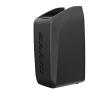
Add new comment
32 comments
I think SRAM have the shifting the wrongway . In Campy and Shimano you push the chain up the cassette with your right hand, I think that is how SRAM should do it, not the other way. I would have thought it would be easy to have software that would let you chose how to shift.
Luv the idea and practice of this - di2 computes well with my thoughts more so than Campy but this hits the mark right on the bulls eye- 2k is pretty heavy tho. bit like a PM but i got one of those LOL..like the idea of seeing the gear selection on the garmin display miss that from the Tiagra levers.
I want very much. Can't decide which child to sell to afford it though.
Sell them all and get yourself a(nother?) nice set of wheels as well :¬)
Can I just say "Kudos" to SRAM's marketing department for the "etap" name though, very clever indeed.
The ginger step-child, surely.
700c: You can get something pretty close to double-shifting, by pressing and holding the lever for the direction you want the rear to go in (e.g. say the right one to change down the cassette), while pressing and releasing the other lever around the same time. The front will shift because you pressed both and released at least one. Shortly after it will start multi-shifting the rear because you're still holding down the lever. Or you can just front shift and tap shift down after.
I was also concerned before that it couldn't shift both front and rear together, but you can make it shift quickly enough in series that it shouldn't be an issue.
Agreed that the double lever shifting sounds odd, (but then so is Shimano's long-standing brake lever-cum-shifter arrangement if you ask me!).
The main drawback of SRAM's system being the inability to shift FD and RD simultaneously - something I do on every single ride, to avoid big jumps in gears when shifting big/small ring.
Unless I'm missing something..?
Nip over to Youtube and watch the GCN guys doing exactly what you say SRAMs system cannot do and doing it time after time after time after time after time after...
https://www.youtube.com/watch?v=68cV00oRK1M
deleted
Am I right in assuming that cross compatibility means you can run this system with Shimano chainset and cassette?
When's the recall date?
All we need now is wireless brakes to really clean a bike's lines up...
Fully internal routing for hydro discs (apart from the last couple of inches to the caliper) is very possible...
I'm liking this the more I see & read of it. You would've that if you just buy shifters & mechs that the charger & USB would also be included though as opposed to having to buy them separately.
Do you have to take the battery packs with you as well as the lights and the GPS unit if you stop for a swift half on the way home? Would I be stranded if they were removed? Seems I'll have to have more than one bike . . . . .
If you can afford this groupset, you can probably afford a commuter as well
Left down, right up - much the same as paddle shift on a car. Then they just had to think of how to incorporate the front mech; so came up with double shifting. I rarely shift the front anyway, so I don't see this as a problem tbh.
Am I the only one who thinks the shifting sounds ridiculous? Left - down, right - up, both - front mech moves? That sounds absurd.
Odd but then SRAM shifting has always been odd. As a Di2 rider I think I might prefer it as the split levers on that system are close together and tricky to operate if your hands are cold or you're wearing glove. As long as the shift is better than their mechanical front mech shifting I think it will work well once you've adjusted. Better than double tap for sure
I have current Red and the front shifting is faultless.
I found that Rival and Force (non-yaw) needed constant fettling but admittedly that was on my winter bike which saw plenty of bad weather and road grime
Agree, it sounds terrible, but this may not be the case in practise...
If you start thinking like that, STI shifting is even more absurd. You push the whole brake lever across to change down?
I think SRAM have implemented this reasonably well.
However, if electronic shifting is as smooth and faultless as they say, I don't know why they didn't go the whole hog and integrate the front and rear shifting into one smooth process. You pre-set a gear/sprocket when you want it to change to the big ring on the way up (and it matches a change on the front with a few on the back, probably), and a (maybe different) gear for the way down. Then you never worry about thinking about the front shifter or rear shifter as different entities, you just go up or down.
I'm probably spending some of my redundancy money come spring, anyway.
The thing is with Di2 , its more hassle to install with the cables but they are internal and not ugly - you fit them once and never again. Plus the seatpost battery hardly ever needs charging and cannot be stolen/removed/damaged in a crash/bike drop. Also the shifters have no batteries so nothing to worry about there, fit and forget.
I'd still go for Di2 unless this worked out cheaper for most builds.
Where it does have lots of potential is in the retrofit market for bikes that are not di2 compatible - this means almost ANY bike can go electronic, so a big advantage there. I always though external di2 set ups where painfully ugly.
Completely agree - I have external Ultegra Di2 and its fugly as sin to the point I was considering a new frameset with internal routing. Think I'll wait for this to trickle down now. The thing that worries me most about external Di2 is cable snags - I've done that more than once and it required a battery pull to fix - so that's another tick in the box for wireless.
Now selling my Di2 any takers....?
"The fact that Airea belongs to SRAM – it’s not an open system – means that the details of exactly how it works are not public. SRAM reckons this helps with security."
Is the last thing you would want to hear from someone who claims that something is secure. See Kerckhoffs's principle.
Exactly. I'd much rather trust a system that's been publicly described and multiple independent security experts have tried to find weaknesses in.
I have no plans to leave cables for a long time to come but this looks like the most thought out (and elegant) design to date...but so it should be, they have had longer to get to market.
Question is will it lure in the Shimano/Campagnolo loyal users?
Way to go is wireless - but I will wait for Campag to do it.
That should give me a while (they are bound to be last) and I might have saved up enough by then.
Pages